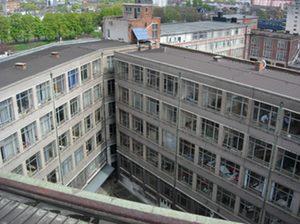Students learn first-hand about energy efficiency at school
youris.com EEIG

An institute in Belgium is about to start retrofitting renovation works. Pupils and teachers have been involved with new courses, visits and an open day. Improving the energy efficiency of existing buildings is a formidable sustainability challenge. And demonstrating it isn’t that easy either.
During an open day, held on 25th April 2015, at the Higher Education Institution of the Province of Liège in Belgium, staff and pupils had the opportunity to learn about the coming eco-friendly changes in their institute.
The building has been selected as a showcase for renovation work aimed at cutting energy consumption by 50%, under the European project BRICKER.
According to Philippe Collée, director of the school, gas bills will be six times lower. “And because of the cogeneration – that is joint production of heat and power – our electricity bill will also decrease," he adds. "Depending on the harshness of the winters, in previous years we’ve had to pay natural gas bills of up to €237,000 for heating a surface of about 23,000 m²,” says Collée.
The renovation will improve the everyday school life of teachers and pupils too. “In winter, students would refuse to sit close to the windows. After the works, things will be much more comfortable,” he adds.
The project sets out to retrofit some of the building’s façades, and to use a highly effective insulation layer based on so-called phase-changing materials. Moreover, double-glazed windows will replace the original single-glazed ones, now including solar protection. And every window will be fitted with an individually working ventilation unit.
What is so unique about these renovations, which are set to start during the summer of 2015, is that they will preserve the original architecture: "During the Sixties, fuel cost was no issue. Large window surfaces were innovations in this and other provincial school buildings constructed in the same period. These resulted in an optimal incidence of natural light. I'm very glad the renovation will maintain this transparent character."
Some of the teachers are already planning to adapt their lessons. “Most of the course I teach focuses on heating systems. Now that [the project] is beginning, I'll add a section on renovation,” says Gabrielle Masy, professor in heating technologies. Beyond changes in the curriculum, school awareness and wider-community involvement may be key factors for success.
Local students have already been told about the project during lessons. However, their real involvement will only start after most of the works are finished. "Traditionally my classes visit the school’s heating installations every year. But in 2016 and 2017 they will also carry out measurements about the energy consumption of the building," says Masy.
Students in non-construction disciplines are also aware that the project is going on. "I think the involvement of the school and its students in the renovation is a good thing," says Florian Cecatto. "I'm studying to be a land surveyor, so my studies don't involve energy efficiency or heating. But, like most members of my generation, I'm convinced that such an ecological and durable approach is important."
Finally, the school management and the provincial authority have also been heavily involved. "The Liège province and its schools follow [the renovation project] very closely," informs Collée. "Several other province-owned buildings were constructed in the same period –the Sixties—and with the same materials and techniques as ours. If [this renovation] proves to be a success, candidates for a similar renovation will apply soon,” he concludes.
by Koen Mortelmans
Photo: the Rennequin Sualem provincial school in Liège. Credits: Koen Mortelmans.



